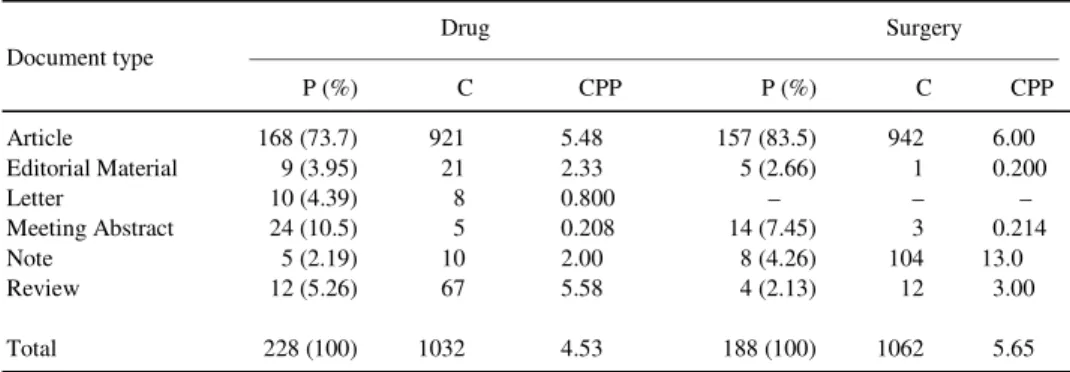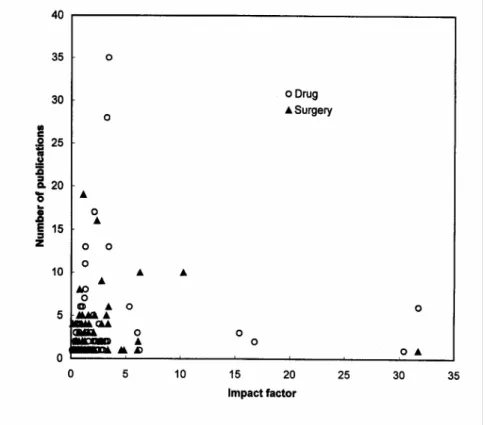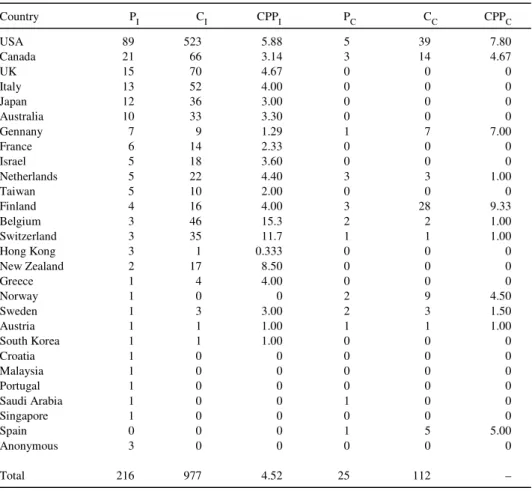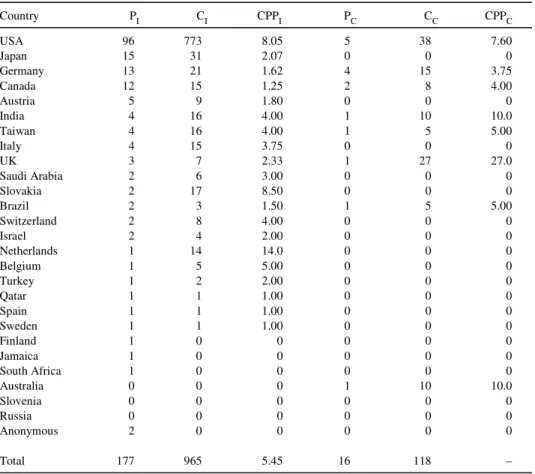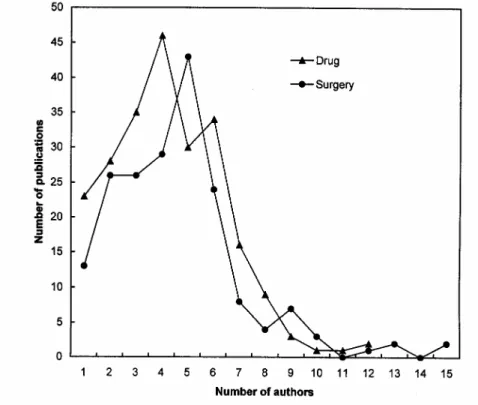Received February 9, 2004 Address for correspondence: YUH-SHAN HO
School of Public Health, Taipei Medical University 250 Wu-Hsing Street, Taipei 11014, Taiwan E-mail: ysho@tmu.edu.tw
Bibliometric analysis of
Patent Ductus Arteriosus treatments
WANG-HUU HSIEH,a WEN-TA CHIU,a YEE-SHUAN LEE,a YUH-SHAN HOb
aTaipei Medical University -Wan-Fang Hospital, Taipei (Taiwan) bSchool of Public Health, Taipei Medical University, Taipei (Taiwan)
A bibliometric analysis was performed to assess the quantitative trend of Patent Ductus Arteriosus (PDA) treatment research, including intravenous injection of indomethacin and surgery. The documents studied were retrieved from the Science Citation Index (SCI) for the period from 1991 to 2002. The publication pattern concerning authorship, collaboration, original countries, citation frequency, document type, language of publication, distribution of journals, page count and the most frequently cited papers were performed. The results indicated that either treatment was not the recent emphasis of PDA research. The publishing countries of both treatments have also denoted that these researches were mostly done in Europe and North America. Both surgery and drug treatments had few international collaboration papers. English was the dominant language, and collaboration of two to six authors was the most popular level of co-authorship.
Introduction
The ductus arteriosus, connecting the main pulmonary arteries and the aortic arch, always closed within 2 days of birth (RUDOLPH et al., 1961). If the ductus remains open, then it is called Patent Ductus Arteriosus (PDA). PDA occurs around 5% to 10% in all congenital heart disease where the male to female ratio is 1 to 3 (MITCHELL et al., 1971). Treatments of PDA can be conducted in two ways: intravenous injection of indomethacin or ibuprofen and surgery of coil embolization or surgical ligation. The most effective treatment for premature PDA infants is intravenous injection of indomethacin. However, the drug treatment does not work for infants older than 1 month. The coil embolization of surgery treatment can only be applied when smaller PDA size occurred (PATEL et al., 1999). The surgical ligation is limited to patients that reach the weight limit, otherwise it would lead to branchiolitis or pheumothorax. Bibliometric analysis is a quantitative analysis done to aid the evaluation of research performances (VAN DEN BERGHE, 1998). Recent increasing use of bibliometric analysis of institutes (JEEVAN & GUPTA, 2002), journals (SCHUBERT, 1996), grants and many
others has been indicating its importance. Publication output of a certain discipline or topic can represent its current research trend whether it is present, previous, or future research focus (GARFIELD, 1970).
The purpose of this study, on the basis of bibliometric analysis, was to evaluate the research trend of the treatments of PDA, by drug and surgery. The drug treatment included indomethacin or ibuprofen intravenous injection; the surgery treatment included coil embolization and surgical ligation.
Method
The graphic data on treatments, by surgery and drug, were retrieved from the
Science Citation Index (SCI) database for the period from 1991 to 2002. SCI was
established by the Institute for Scientific Information (ISI) for the purpose of indexing articles and forming the bases for bibliometric analysis. Patent Ductus Arteriosus and indomethacin or ibuprofen was used as the keyword to search as a part of the title, abstract or keyword for drug treatment. The documents under surgery treatment were searched with keyword Patent Ductus Arteriosus and surgical ligation or coil. All document types, including article, editorial material, letter, meeting abstract, note and review, were used.
The bibliometric impact of a publication is assessed in terms of the number of citations received as compared to other outputs in the journal. Let the total number of papers be P and C the number of total citations for first three years since papers were published. The average number of citations per publications (CPP) was defined as the total number of citations over the total number of publications. In some cases, we only discussed the documents published in the period from 1991 to 2000 because there were no data for CPP after 2000.
Results and discussion
Publication output
The results of the publication output are shown in Table 1. A significant correlation was found between the yearly cumulative number of publications and the year (Figure 1). For the period from 1991 to 2002, the cumulative number of publications has increased in both of sub-subjects, drug and surgery treatments. In 1991, 25 papers were published, while in 2002 the cumulative number of publications was 281 for drug treatment. The relationship between yearly cumulative number of publications and the year was linear with a high correlation coefficient (0.997). In the same period,
on the other hand, only 4 papers were published on surgery treatment, and the cumulative number of publications in 2002 was 233. A significant correlation was found between cumulative number of publications and the year. A double logarithmic plot of the data showed that there was a linear relation with high correlation coefficient (0.961) for surgery treatment. The difference of the cumulative trend between the drug and surgery treatment was significant in the period from 1991 to 1996. After 1996, both drug and surgery treatments have linear relationship between cumulative number of publications and the year. Linear fitting suggested that there is a constant publications rate in each year. However, the logistic curve fitting denoted that yearly publications show a constant growth rate.
Figure 1. Relationship between cumulative number of publications and year for surgery and drug treatment documents
Table 1. Annual production of surgery and drug treatment
PDA Drug Surgery
Year
No.P Cumulative No. P Cumulative No. P Cumulative
1991 105 105 25 25 4 4 1992 100 205 18 43 2 6 1993 130 335 26 69 8 14 1994 134 469 25 94 6 20 1995 134 603 25 119 17 37 1996 168 771 23 142 46 83 1997 161 932 17 159 26 109 1998 128 1060 14 173 27 136 1999 153 1213 29 202 28 164 2000 148 1361 26 228 24 188 2001 151 1512 29 257 26 214 2002 130 1642 24 281 19 233
No. P: Number of publications
Document type
The drug documents are distributed more scattered than those of surgery in the document type during the period from 1991 to 2000. 73.7% of drug documents and 83.5% of surgery documents were original articles (Table 2). The number of total citations for first three years after publication were further considered for the CPP distribution between drug and surgery treatments. That was significantly different partially due to publication output. The CPP values for articles were 5.48 and 6.00 for drug and surgery treatments, respectively. As for CPP in articles, both drug and surgery ranked second. However, the CPP of drug review ranked first and the CPP of surgery note ranked first leading in distance by article.
Table 2. Document type distribution of surgery and drug treatment
Drug Surgery Document type P (%) C CPP P (%) C CPP Article 168 (73.7) 921 5.48 157 (83.5) 942 6.00 Editorial Material 9 (3.95) 21 2.33 5 (2.66) 1 0.200 Letter 10 (4.39) 8 0.800 – – – Meeting Abstract 24 (10.5) 5 0.208 14 (7.45) 3 0.214 Note 5 (2.19) 10 2.00 8 (4.26) 104 13.0 Review 12 (5.26) 67 5.58 4 (2.13) 12 3.00 Total 228 (100) 1032 4.53 188 (100) 1062 5.65
Language of publication
95.4% drug and 91.4% surgery publications in the period from 1991 to 2002 were in English. Surgery documents have contained more articles in German (7.73%) and one in French and Spanish, respectively. Publications in several other languages have been found in drug documents, including German, Italian and Japanese.
Distribution of journals
The average documents published per journal, from 1991 to 2002, was 2.99 and 3.12 for surgery and drug, respectively. Eight journals from surgery and 17 from drug were not found in Journal Citation Reports (JCR). The impact factor (IF) of a journal was determined for each document as reported in the year 2002 JCR. Figure 2 shows that the impact factors of the publishing journals were scattered and did not demonstrate a significant trend. The average impact factor of the journals in surgery was 2.45 and 3.25 for drug journals. The journal with the highest impact factor (31.736) for both treatments was the New England Journal of Medicine. That the average of surgery journals’ impact factor is lower might be due to having only one journal with impact factor higher than 15 where drug treatment had 4.
Page count
In the period from 1991 to 2000, there were 1249 and 1036 pages in total of 228 and 188 publications with an average of 5.48 and 5.51 pages for drug and surgery, respectively. Three to seven pages were popular which included 64.5% of all drug documents and surgery was 70.2%. Six-page papers (42, 18.4%) dominated most of the documents for drug with CPP value of 6.69, while most documents for surgery were dominated by four-page papers (38, 20.2%) with CPP value of 4.74.
International collaboration
Documents in both categories from 1991 to 2000 showed low percentage share of international collaboration, 5.26% and 5.85% for drug and surgery, respectively. This illustrated that international collaboration was not often conducted whose phenomenon was similar to engineering disciplines (SCHUBERT, 1998). Tables 3 and 4 show that the papers published have been diverse. Drug publications cover 27 countries, while those of surgery cover 26. USA has been dominant by publishing 94 (45.4%) and 101 (53.7%) papers with CPP of 5.98 and 8.03 for drug and surgery, respectively, followed by the second ranking with a four- and six-fold less in these two parts. In addition to its dominant publication, USA also produced most international collaborated papers. For
the surgery part, the international collaboration CPP was 8.82, which was higher than 4.58 for drug. As for the non-international collaboration papers, the CPP of surgery was 5.45 and that of drug was 4.52.
Figure 2. Impact factors’ distribution of journals published
Authorship
Figure 3 shows a similar trend of publication and numbers of authors for drug and surgery papers published from 1991 to 2000. With drug treatment papers, four to six authorships were 48.2% and citation was 51.4%. The most frequent authorships for drug was four with 20.2% publications and 14.8% citation with CPP value of 3.33. However, the phenomenon is different for surgery treatment papers. Two to five authorships were 66.0% publication and 66.8% citation. Besides, five authorships were most frequent with 22.9% publication and 21.2% citation having the CPP value of 5.23.
Table 3. International collaboration country distribution of drug documents Country PI CI CPPI PC CC CPPC USA 89 523 5.88 5 39 7.80 Canada 21 66 3.14 3 14 4.67 UK 15 70 4.67 0 0 0 Italy 13 52 4.00 0 0 0 Japan 12 36 3.00 0 0 0 Australia 10 33 3.30 0 0 0 Gennany 7 9 1.29 1 7 7.00 France 6 14 2.33 0 0 0 Israel 5 18 3.60 0 0 0 Netherlands 5 22 4.40 3 3 1.00 Taiwan 5 10 2.00 0 0 0 Finland 4 16 4.00 3 28 9.33 Belgium 3 46 15.3 2 2 1.00 Switzerland 3 35 11.7 1 1 1.00 Hong Kong 3 1 0.333 0 0 0 New Zealand 2 17 8.50 0 0 0 Greece 1 4 4.00 0 0 0 Norway 1 0 0 2 9 4.50 Sweden 1 3 3.00 2 3 1.50 Austria 1 1 1.00 1 1 1.00 South Korea 1 1 1.00 0 0 0 Croatia 1 0 0 0 0 0 Malaysia 1 0 0 0 0 0 Portugal 1 0 0 0 0 0 Saudi Arabia 1 0 0 1 0 0 Singapore 1 0 0 0 0 0 Spain 0 0 0 1 5 5.00 Anonymous 3 0 0 0 0 0 Total 216 977 4.52 25 112 –
PI: Single country publication output CI: Times cited of single country publication
CPPI: Citation per publication of single country publication PC: International collaboration publication output CC: Times cited of international collaborated publication
CPPC: Citation per publication of international collaborated publication
The most frequently cited papers
The time dependence for a single article is called its history and may be viewed as the ‘sales figure’ of the article (MARX & CARDONA, 2003). Among PDA related papers, the most frequently cited was ‘Very-Low-Birth-Weight Outcomes of the National-Institute-of-Child-Health-and-Human-Development Neonatal Network’.
Table 4. International collaboration country distribution of surgery documents Country PI CI CPPI PC CC CPPC USA 96 773 8.05 5 38 7.60 Japan 15 31 2.07 0 0 0 Germany 13 21 1.62 4 15 3.75 Canada 12 15 1.25 2 8 4.00 Austria 5 9 1.80 0 0 0 India 4 16 4.00 1 10 10.0 Taiwan 4 16 4.00 1 5 5.00 Italy 4 15 3.75 0 0 0 UK 3 7 2.33 1 27 27.0 Saudi Arabia 2 6 3.00 0 0 0 Slovakia 2 17 8.50 0 0 0 Brazil 2 3 1.50 1 5 5.00 Switzerland 2 8 4.00 0 0 0 Israel 2 4 2.00 0 0 0 Netherlands 1 14 14.0 0 0 0 Belgium 1 5 5.00 0 0 0 Turkey 1 2 2.00 0 0 0 Qatar 1 1 1.00 0 0 0 Spain 1 1 1.00 0 0 0 Sweden 1 1 1.00 0 0 0 Finland 1 0 0 0 0 0 Jamaica 1 0 0 0 0 0 South Africa 1 0 0 0 0 0 Australia 0 0 0 1 10 10.0 Slovenia 0 0 0 0 0 0 Russia 0 0 0 0 0 0 Anonymous 2 0 0 0 0 0 Total 177 965 5.45 16 118 –
PI: Single country publication output CI: Times cited of single country publication
CPPI: Citation per publication of single country publication PC: International collaboration publication output CC: Times cited of international collaborated publication
CPPC: Citation per publication of international collaborated publication
This paper, in 1991 by HACK et al. from USA, was published in Pediatrics and was cited 293 times since its publishing to 2003. This paper was also related to surgery treatment. Regarding the drug treatment related papers, ‘Neonatal complications after the administration of indomethacin for preterm labor’, in 1993 by NORTON et al. from USA, was the most frequently cited. It was published in the New England Journal of
Medicine and was cited 157 times to 2003. The citation history of the most frequently
cited papers for drug and surgery was shown in Figure 4. The citations reached to a maximum after 4 years' publication for surgery and 2 years’ for drug. The peak position depended on the research discipline and was shifted to about 4 years in the case of
technical sciences (MARX & CARDONA, 2003). In addition, different fields show dissimilar citation frequency where the present impact factor accounted citation only for two years after publication (ZETTERSTROM, 2002). The citation pattern of the most cited PDA article may suggest that the impact factor be accounted for longer period after publication to maintain a better citation overview.
Figure 3. Comparison of number of publications and number of authors for surgery and drug treatment documents
Conclusion
PDA is a kind of heart diseases for infants. Compared with other kinds of heart diseases, it is not the most serious. However, it is sometimes fatal to a newborn baby. In this study, we have evaluated and analysed PDA treatments on surgery and drug by using the bibliometric tools. Though the study showed that both the treatments
Figure 4. Citation pattern of the most frequently cited articles for surgery and drug treatment
were not the focus of PDA research, we still obtained some significant points that could contribute further studies to decrease the mortality of the disease. The paper denoted that yearly publications sustain constantly in each year for drug and in the later period of 90’s for surgery treatment. However, the surgery treatment was a constant growth rate on publications in the early 90’s. The average impact factor of the drug journals was higher than that of surgery’s. The countries in which the documents of surgery and drug treatments were published have denoted that most of these researches were done by Europe and North America. Both of surgery and drug treatments had low international collaboration papers. The dominant language was English. Besides, two to six author group collaboration was a popular method as co-authorship.
References
GARFIELD, E.(1970), Citation indexing for studying science. Essays of an Information Scientist, Vol. 1, pp. 133–138.
HACK, M., HORBAR, J. D., MALLOY, M. H., TYSON, J. E., WRIGHT, E., WRIGHT, L. (1991), Very low birth weight outcomes of the National Institute of Child Health and human development neonatal network. Pediatrics, 87 : 587–597.
HAVEMANN, F. (2001), Collaboration behaviour of Berlin life science researchers in the last two decades of the twentieth century as reflected in the Science Citation Index. Scientometrics, 52 : 435–443.
JEEVAN, V. K. J., GUPTA, B. M. (2002), A scientometric analysis of research output from Indian Institute of Technology, Kharagpur. Scientometrics, 53 : 165–168.
MARX, W., CARDONA, M. (2003), The impact of Solid State Communications in view of the ISI citation data. Solid State Communications, 127 : 323–336.
MITCHELL, S. C., KORONES, S. B., BERENDES, H. W. (1971), Congenital heart disease in 56,109 births incidence and natural history. Circulation, 43 : 323–332.
NORTON, M. E., MERRILL, J., COOPER, B. A. B., KULLER, J. A., CLYMAN, R. I. (1993), Neonatal complications after the administration of indomethacin for preterm labor. New England Journal of Medicine, 329 : 1602–1607.
PATEL, H. T., CAO, Q. L., RHODES, J., HIJAZI, Z. M. (1999), Long-term outcome of transcatheter coil closure of small to large patent ductus arteriosus. Catheterization and Cardiovascular Interventions, 47 : 457–461.
RUDOLPH, A. M., DRORBAUGH, J. E., AULD, P. A. M., RUDOLPH, A. J., NADAS, A. S., SMITH, C. A., HUBBELL, J. P. (1961), Studies on the circulation in the neonatal period; The circulation in the respiratory distress syndrome. Pediatrics, 27 : 551–566.
SCHUBERT, A. (1996), The portrait of a journal as reflected in its publications, references and citations: Inorganica Chimica Acta, 1990–1994. Inorganica Chimica Acta, 253 : 111–118.
SCHUBERT, A. (1998), The profile of the Chemical Engineering Journal and Biochemical Engineering Journal as reflected in its publications, references and citations, 1983–1996. Chemical Engineering Journal, 69 : 151–156.
VAN DEN BERGHE, H., HOUBEN, J. A., DE BRUIN, R. E., MOED, H. F., KINT, A., LUWEL, M., SPRUYT, E. H. J. (1998), Bibliometric indicators of university research performance in Flanders. Journal of the American Society for Information Science, 49 : 59–67.
ZETTERSTROM, R. (2002), Bibliometric data: A disaster for many non-American biomedical journals. Acta Paediatrica, 91 : 1020–1024.

